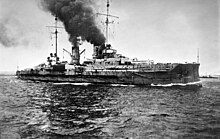List of armored cruisers of Germany
[1] Due to budget constraints, the navy was unable to build cruisers designed solely for fleet service or for overseas duties.
[4][a] Fürst Bismarck proved to be "ideally suited"[2] to overseas duties and formed the basis for subsequent armored cruiser designs.
[2] Prinz Heinrich followed in 1898 and incorporated several alterations, including a reduced primary armament, a thinner but more comprehensive armor system, and a higher top speed.
[5] The two Scharnhorst-class armored cruisers, laid down in 1904 and 1905, were marked improvements over the previous designs; they carried a much heavier armament and were more than 2 knots (3.7 km/h; 2.3 mph) faster than the earlier vessels.
The ship was significantly larger, better armed, and faster than the Scharnhorst class, though she remained inferior to the new Invincible-class battlecruisers then being built by the British Royal Navy.
Naval historian David Lyon remarked that the armored cruisers built by Germany were the "worst designed and least battle-worthy ships" in the navy.
[9] Assigned to the East Asia Squadron, Fürst Bismarck assisted in suppressing the Boxer Uprising before being replaced in 1909 by SMS Scharnhorst.
Modernized upon arriving in Germany, she acted in a coast-defense role early in World War I, but was soon relegated to service as a stationary training ship.
[9] Prinz Heinrich's design was a modification of Fürst Bismarck, and traded a smaller main battery for higher speed and more comprehensive armor protection.
[12] After the outbreak of World War I in August 1914, the ship participated in an operation against the British coast in December 1914,[13] after which she was transferred to the Baltic Sea.
While returning to port after a raid of the English coast on 3–4 November 1914, Yorck struck German mines and sank with heavy loss of life.
They were larger than the Roon class that preceded them; the extra size was used primarily to increase the main armament of 21 cm (8.2 inch) guns from four to eight.
[28] At the Battle of Dogger Bank on 24 January 1915, Blücher was slowed significantly after being hit by gunfire from the British battlecruiser squadron under the command of Vice Admiral Sir David Beatty.
Rear Admiral Franz von Hipper, the commander of the German squadron, decided to abandon Blücher to the pursuing enemy ships in order to save his more valuable battlecruisers.






